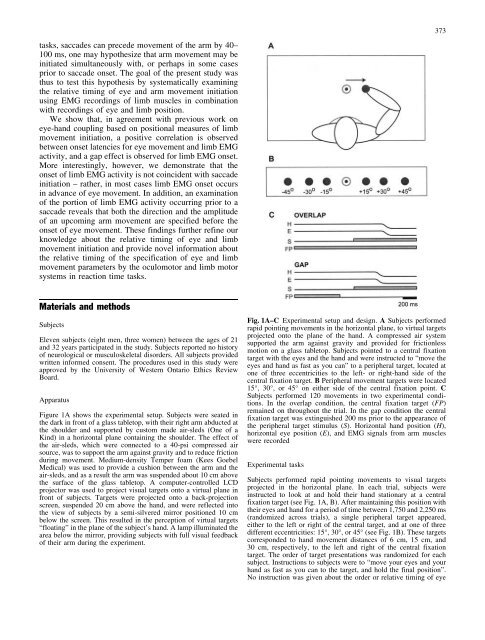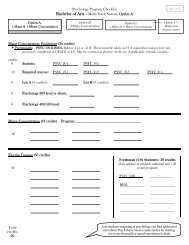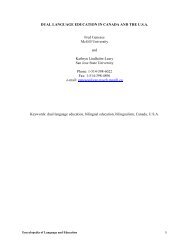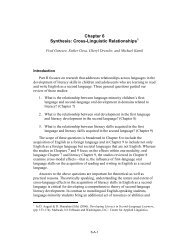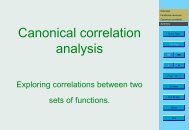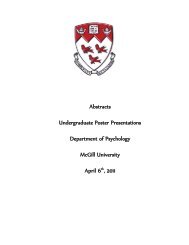Hand-eye coordination for rapid pointing movements - ResearchGate
Hand-eye coordination for rapid pointing movements - ResearchGate
Hand-eye coordination for rapid pointing movements - ResearchGate
You also want an ePaper? Increase the reach of your titles
YUMPU automatically turns print PDFs into web optimized ePapers that Google loves.
tasks, saccades can precede movement of the arm by 40–<br />
100 ms, one may hypothesize that arm movement may be<br />
initiated simultaneously with, or perhaps in some cases<br />
prior to saccade onset. The goal of the present study was<br />
thus to test this hypothesis by systematically examining<br />
the relative timing of <strong>eye</strong> and arm movement initiation<br />
using EMG recordings of limb muscles in combination<br />
with recordings of <strong>eye</strong> and limb position.<br />
We show that, in agreement with previous work on<br />
<strong>eye</strong>-hand coupling based on positional measures of limb<br />
movement initiation, a positive correlation is observed<br />
between onset latencies <strong>for</strong> <strong>eye</strong> movement and limb EMG<br />
activity, and a gap effect is observed <strong>for</strong> limb EMG onset.<br />
More interestingly, however, we demonstrate that the<br />
onset of limb EMG activity is not coincident with saccade<br />
initiation – rather, in most cases limb EMG onset occurs<br />
in advance of <strong>eye</strong> movement. In addition, an examination<br />
of the portion of limb EMG activity occurring prior to a<br />
saccade reveals that both the direction and the amplitude<br />
of an upcoming arm movement are specified be<strong>for</strong>e the<br />
onset of <strong>eye</strong> movement. These findings further refine our<br />
knowledge about the relative timing of <strong>eye</strong> and limb<br />
movement initiation and provide novel in<strong>for</strong>mation about<br />
the relative timing of the specification of <strong>eye</strong> and limb<br />
movement parameters by the oculomotor and limb motor<br />
systems in reaction time tasks.<br />
373<br />
Materials and methods<br />
Subjects<br />
Eleven subjects (eight men, three women) between the ages of 21<br />
and 32 years participated in the study. Subjects reported no history<br />
of neurological or musculoskeletal disorders. All subjects provided<br />
written in<strong>for</strong>med consent. The procedures used in this study were<br />
approved by the University of Western Ontario Ethics Review<br />
Board.<br />
Apparatus<br />
Figure 1Ashows the experimental setup. Subjects were seated in<br />
the dark in front of a glass tabletop, with their right arm abducted at<br />
the shoulder and supported by custom made air-sleds (One of a<br />
Kind) in a horizontal plane containing the shoulder. The effect of<br />
the air-sleds, which were connected to a 40-psi compressed air<br />
source, was to support the arm against gravity and to reduce friction<br />
during movement. Medium-density Temper foam (Kees Goebel<br />
Medical) was used to provide a cushion between the arm and the<br />
air-sleds, and as a result the arm was suspended about 10 cm above<br />
the surface of the glass tabletop. Acomputer-controlled LCD<br />
projector was used to project visual targets onto a virtual plane in<br />
front of subjects. Targets were projected onto a back-projection<br />
screen, suspended 20 cm above the hand, and were reflected into<br />
the view of subjects by a semi-silvered mirror positioned 10 cm<br />
below the screen. This resulted in the perception of virtual targets<br />
“floating” in the plane of the subject’s hand. Alamp illuminated the<br />
area below the mirror, providing subjects with full visual feedback<br />
of their arm during the experiment.<br />
Fig. 1A–C Experimental setup and design. A Subjects per<strong>for</strong>med<br />
<strong>rapid</strong> <strong>pointing</strong> <strong>movements</strong> in the horizontal plane, to virtual targets<br />
projected onto the plane of the hand. Acompressed air system<br />
supported the arm against gravity and provided <strong>for</strong> frictionless<br />
motion on a glass tabletop. Subjects pointed to a central fixation<br />
target with the <strong>eye</strong>s and the hand and were instructed to “move the<br />
<strong>eye</strong>s and hand as fast as you can” to a peripheral target, located at<br />
one of three eccentricities to the left- or right-hand side of the<br />
central fixation target. B Peripheral movement targets were located<br />
15, 30, or 45 on either side of the central fixation point. C<br />
Subjects per<strong>for</strong>med 120 <strong>movements</strong> in two experimental conditions.<br />
In the overlap condition, the central fixation target (FP)<br />
remained on throughout the trial. In the gap condition the central<br />
fixation target was extinguished 200 ms prior to the appearance of<br />
the peripheral target stimulus (S). Horizontal hand position (H),<br />
horizontal <strong>eye</strong> position (E), and EMG signals from arm muscles<br />
were recorded<br />
Experimental tasks<br />
Subjects per<strong>for</strong>med <strong>rapid</strong> <strong>pointing</strong> <strong>movements</strong> to visual targets<br />
projected in the horizontal plane. In each trial, subjects were<br />
instructed to look at and hold their hand stationary at a central<br />
fixation target (see Fig. 1A, B). After maintaining this position with<br />
their <strong>eye</strong>s and hand <strong>for</strong> a period of time between 1,750 and 2,250 ms<br />
(randomized across trials), a single peripheral target appeared,<br />
either to the left or right of the central target, and at one of three<br />
different eccentricities: 15, 30, or 45 (see Fig. 1B). These targets<br />
corresponded to hand movement distances of 6 cm, 15 cm, and<br />
30 cm, respectively, to the left and right of the central fixation<br />
target. The order of target presentations was randomized <strong>for</strong> each<br />
subject. Instructions to subjects were to “move your <strong>eye</strong>s and your<br />
hand as fast as you can to the target, and hold the final position”.<br />
No instruction was given about the order or relative timing of <strong>eye</strong>


